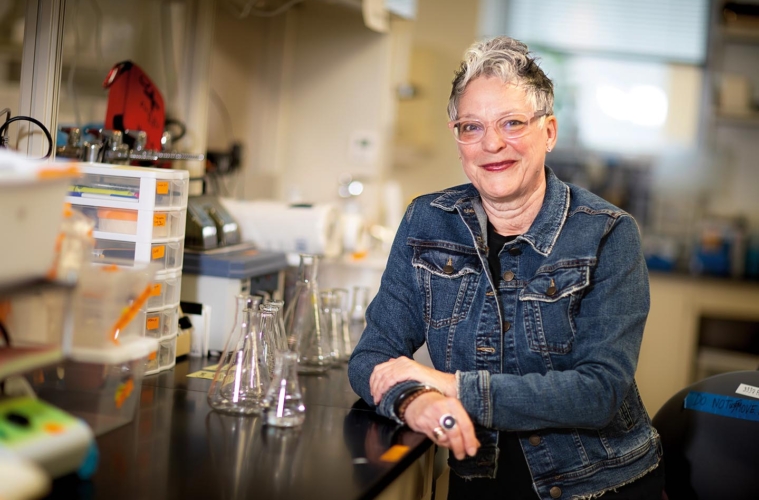Kathy High ’77 co-founded an artists collective and is a new media/video professor at RPI.
Kathy High ’77 stands on the steps of the Sanctuary For Independent Media, a converted church in Troy, N.Y., that serves as the hub of the artist collective she co- founded. Their mission: to foster community and advocate for social and environmental justice through the lens of interdisciplinary art practices. Bundled up against the autumn chill, yet impossibly cool with a tousled silver pixie cut and combat boots, High guides visitors through the Sanctuary’s rehabilitated buildings, community gardens, urban nature walks, and research labs along the city’s down-and-out 6th Avenue.
The tour not only highlights the Sanctuary’s commitment to revitalization, but also mirrors the zeal High brings to the videos, photographs, writings, performances, and installations she creates at Rensselaer Polytechnic Institute (RPI), where she’s a professor of video and new media. At RPI and through the Sanctuary, High is reshaping the intersection of art, science, and activism, addressing global challenges from gut health to climate change.
“Artists are in a perfect position to make interesting forays into science,” says High, who credits Colgate for sparking the passion that has guided her career. Studying with faculty members like new media artist Patrick Clancy, “I was amazed you could make a film or videotape; I had no idea outside Hollywood,” she says. Her immersion in new media led her to New York City, where she worked in film and TV post-production. She launched the magazine FELIX, Journal of Media Arts and Communication, which elevated video art, and she became a noted scholar on the subject, as well as the history of video technologies and systems.
High was just getting started. Her myriad interests encompass body politics, the paranormal, gender issues, anti-war activism, animal sentience, decomposition, and immortality. In 2000, her fascination with biological art led her to RPI, where she became a catalyst for a vibrant interdisciplinary community, exploring living systems and the social, political, and ethical dilemmas inherent in biotechnology and related industries. Embracing Animal, inspired by High’s battle with Crohn’s disease, unveils the often-overlooked contribution of lab animals to scientific advancements.
High is currently collaborating with scientists at the Medical Museion in Copenhagen to explore the human gut microbiome. This complex community of microorganisms, including bacteria, viruses, fungi, and other microbes, plays a crucial role in our digestion. High and her collaborators use human feces — including High’s — to study how the composition of the gut microbiome can be influenced by factors like diet, lifestyle, and the environment.
High extends this interdisciplinary approach to the Sanctuary, where she and her collaborators bring together various disciplines to address pressing social issues like climate change, hunger, and water pollution. Grants from organizations, including the federal Department of Environmental Conservation, have facilitated transforming once-neglected lots in downtown Troy into vibrant, environmentally conscious community spaces complete with fruit trees and medicinal gardens.
Her dedication to environmentalism is manifested in the Sanctuary’s North Troy Art, Technology and Urban Research in Ecology Lab (NATURE Lab), where High conducts research on air, soil, and water toxins. Among many other initiatives, NATURE Lab provides DIY testing kits for lead, copper, and arsenic and extends outreach to high school and middle school students through tailored programs.
As the collective looks to the future, High envisions expanding residency opportunities for artists, fostering racial equity in STEM education, and developing innovative summer camps, among other priorities.
“Science is on the forefront of a lot of the decisions that are shaping our future,” she says. “As citizens, we need to educate ourselves to see what’s happening in that field and to be critical.”

